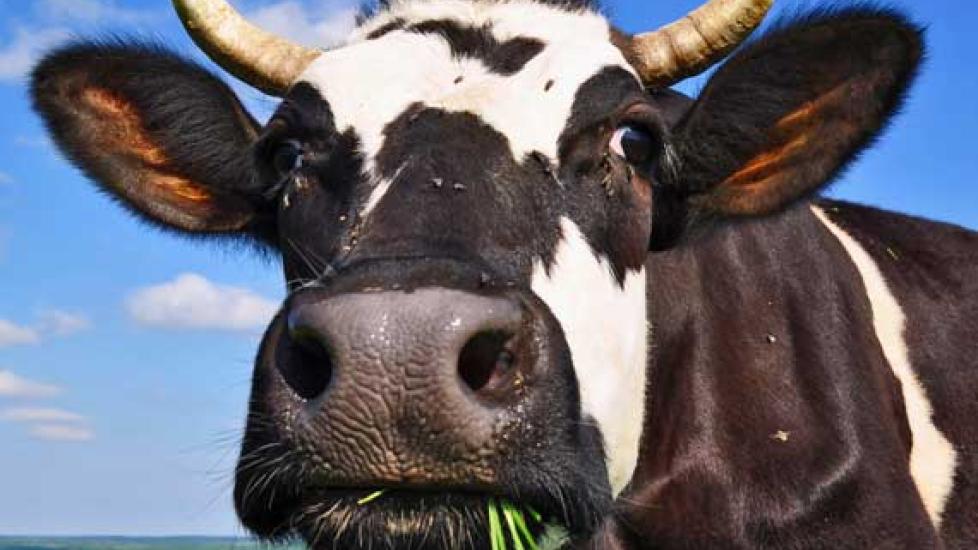The Amazing and Wondrous Fistulated Cow
I hope over the past couple of years, I’ve been able to demonstrate how truly unique and downright cool cows are. Giant walking fermentation vats with four stomachs that have the capacity to produce gallons of milk a day, retain the capability to calmly remain standing during invasive abdominal surgery, and have the ability to survive being poked from the inside-out with nails and other metal objects merely by swallowing a magnet — forget cool, these creatures are amazing! (Or should I say: a-moo-sing?)
Puns and hyperbole aside, I’d like to tell you about yet another cool cow aspect: Some fellow bovines can have a hole permanently installed from the outside into their rumen. This hole is called a fistula. Usually kept at a veterinary school, large veterinary clinic, or dairy, a fistulated cow is an extra-special cow because she is used to donate her rumen microbes to other sick cows. Here’s how it all works.
A cow’s overall health is very much dictated by how healthy her rumen gut bugs, called “microflora,” are. When a cow is sick, her microflora can die, wreaking havoc on her digestive system. Sometime it’s a challenge to re-grow those gastrointestinal bugs. This is where a fistulated cow comes in handy.
Surgically speaking, installing a fistula into a cow’s rumen is a relatively simple process. A hole is cut through the right side of the cow’s flank and into the rumen (the rumen is always on the cow’s right side). A rubber ring is inserted and permanently installed. This procedure does not take very long and is performed with the cow standing. The cow’s flank is numbed with local anesthetic and once installed, the fistula causes no pain. And of course it has a cap, to prevent leakage.
Then comes the fun part. When a sick cow comes in and needs some healthy rumen microbes, someone lucky gets to put on a shoulder-length glove, undo the lid of the fistula, and sink his or her arm right inside the 50 gallon rumen of the healthy fistulated cow. It’s a crazy experience; it’s very warm and moist, as you might expect, but you also can appreciate the contractions and rumblings of the stomach in action!
After you’re done being the rumen tourist, you grab a few large handfuls of ingesta, which is usually liquefied hay and grass. You pull this out, put it in a clean bag that has been sitting in warm water, and then rush over to the sick cow with the goodies.
You administer the good microbes to the sick cow via orogastric tube — sort of like force-feeding — and then give her a few days to see if her appetite has improved. Monitoring her manure also helps indicate how her gastrointestinal tract is improving.
You may wonder whether there are diseases that can be transmitted from fistulated cow to sick cow. Usually, no. Fistulated cows themselves are pretty healthy and kept out of trouble — they are not bred or milked or stressed, and don’t travel so as to become exposed to contagious diseases. And as far as accidentally spreading “bad” gut microbes, it’s all in numbers — the vast majority of gut microbes in a healthy cow are good, keeping the bad ones in check.
Another cool thing about fistulated cows is that their ingesta can be used for other ruminant species, too. Goats and sheep in need of some microbial boosts for their guts can take a dose or two from a fistulated cow, and I’ve used cow ingesta to help sick alpacas, too.
I fondly remember the fistulated cow at vet school. Her name was Buttercup and all the senior vet students who rotated in on their large animal clinic rotation and assigned her daily care doted on her. She was spoiled — big time.
Needless to say, fistulated cows are worth their weight in gold. One fistulated cow in a geographical area often ends up helping out animals from different counties and sometimes even states! This raises the question: Does a fistulated cow ever run out of ingesta? I think you’d have to borrow pretty heavily to run into trouble in that regard. Besides, you can use your arm as a gauge — finding yourself digging deep? Just offer her more feed! Her rumen levels should be up by the next morning.

Dr. Anna O'Brien
Image: smereka / Shutterstock
